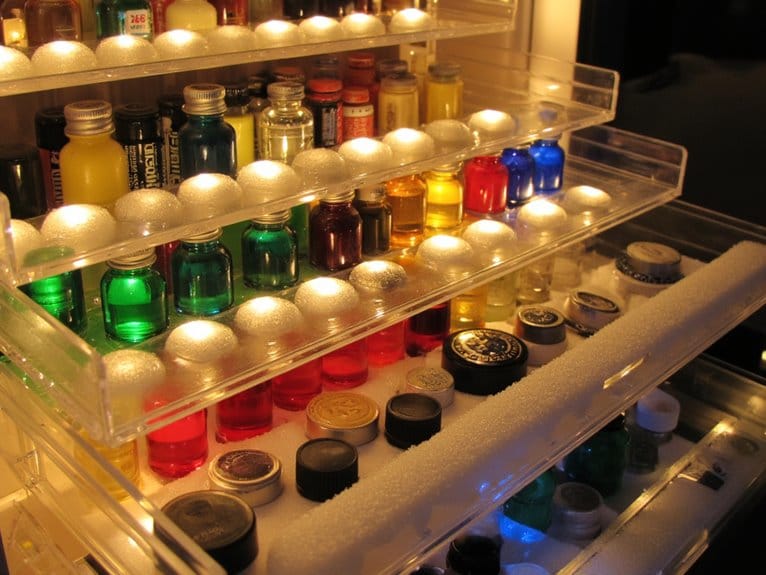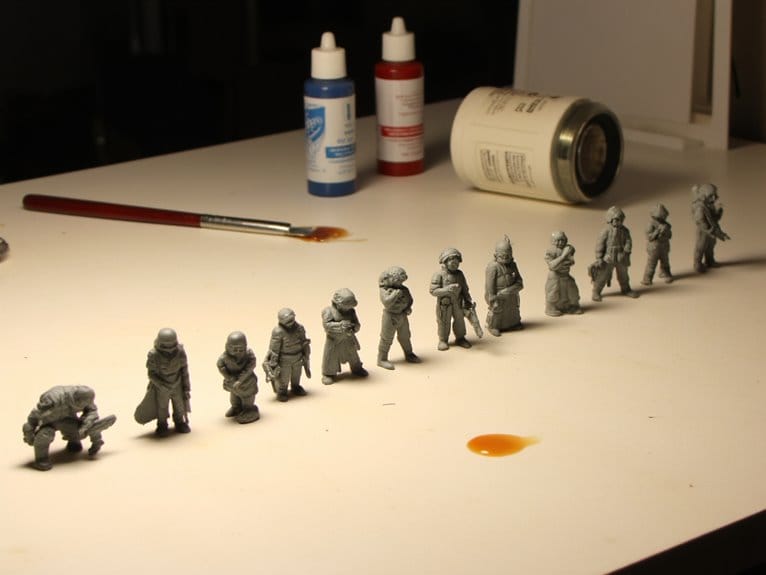We are supported by our audience. When you purchase through links on our site, we may earn an affiliate commission, at no extra cost for you. Learn more. Last update on 1st July 2025 / Images from Amazon Product Advertising API.
You’ll thin miniature paints by starting with undiluted paint on your palette, then gradually adding water in a 1:3 or 1:4 ratio until you achieve a milk-like consistency. Mix thoroughly and test on a spare surface before applying to your miniature. Use wet palettes to prevent premature drying, and adjust consistency every 30 minutes during extended sessions. For washes, increase dilution to 1:1, while glazes require even thinner ratios up to 1:8. Master these fundamentals to reveal advanced techniques.
Notable Insights
- Start with small amounts of paint and gradually add water in a 1:3 or 1:4 ratio for proper dilution control.
- Aim for a “skimmed milk” consistency that flows smoothly while maintaining pigment coverage and detail preservation.
- Use wet palettes to prevent premature drying and maintain workable paint consistency throughout extended painting sessions.
- Test thinned paint on spare surfaces before applying to miniatures to ensure optimal transparency and coverage levels.
- Adjust ratios based on technique: milk-like consistency for base coats, watery consistency for washes and glazing effects.
Essential Tools and Materials for Paint Thinning
The foundation of successful paint thinning begins with selecting the right tools and materials for your miniature painting workspace.
Choosing quality tools and materials forms the cornerstone of achieving professional paint thinning results in miniature work.
You’ll need clean palettes as your primary mixing surface. Wet palettes provide moisture that naturally thins acrylics while preventing premature drying. Water serves as the most common thinner for hobby paints, though commercial flow improvers offer enhanced texture control.
Essential accessory options include dropper bottles for precise thinner measurement, palette knives for thorough mixing, and small containers for batch preparation. Eye droppers guarantee accurate dispensing ratios. Paper towels maintain clean work surfaces between color changes.
Proper mixing techniques require consistent stirring with brush handles or disposable stirrers. Clean tools between applications to prevent color contamination. Filter water sources to remove mineral contaminants that can negatively affect paint performance.
Test consistency on non-porous surfaces, aiming for milk-like transparency that maintains pigment adhesion and color retention. Professional flow improvers typically require a 1-2 drops per 10 drops of paint ratio for optimal results. Specialized flow improvers maintain pigment integrity while providing superior thinning results compared to water alone.
Understanding Paint Consistency Basics
Paint consistency determines every aspect of your miniature’s final appearance, from surface smoothness to detail preservation. Achieving proper viscosity prevents thick layers from obscuring fine details while ensuring adequate coverage.
The “skimmed milk” benchmark provides a starting point, but importance factors like pigment load and color variations require individual adjustments. Red, orange, and yellow paints naturally possess thinner consistency with weaker coverage. White paints contain higher pigment concentrations, demanding more thinning.
| Consistency Type | Viscosity | Primary Use | Coverage | Technique |
|---|---|---|---|---|
| Thick | Undiluted | Dry brushing | Opaque | Texture effects |
| Medium | 2:1 water ratio | Base coats | Good | Standard layering |
| Thin | 3:1 water ratio | Glazing | Translucent | Color blending |
| Wash | 4:1 water ratio | Recesses | Transparent | Shadow depth |
| Glaze | 5:1 water ratio | Tinting | Minimal | Color adjustment |
Test consistency on your thumb’s back surface to verify translucency levels. A wet palette will help maintain consistent paint viscosity throughout extended painting sessions, preventing your thinned paints from drying out and changing consistency. Water-based thinners produce fewer harmful fumes and maintain excellent fluidity for indoor miniature painting sessions. Proper edge highlighting requires finding the perfect balance between paint flow and brush control to achieve crisp lines without lumpy buildup.
Step-by-Step Thinning Process
Five essential steps transform thick acrylic paint into the perfect consistency for miniature work. First, dispense a small amount of undiluted paint onto your palette.
Second, add thinning medium gradually—start with half the paint’s volume.
Third, mix thoroughly using a brush or palette knife until the mixture appears uniform.
Fourth, test the diluted paint on a spare surface to evaluate flow and coverage.
Fifth, adjust consistency by adding more medium in small increments.
These thinning techniques require careful observation of paint viscosity. For basecoating, achieve a skim milk consistency that covers without obscuring details. Remember that different paint brands require varying dilution approaches due to their unique formulations and viscosity characteristics. Keeping paint in a drop increases longevity and reduces waste during the thinning process.
For glazing, thin further until the paint becomes transparent.
For washes, increase dilution until the paint flows freely while retaining color saturation. High-concentration pigments in quality acrylic paints will maintain rich, intense colors even when significantly diluted. Test regularly and maintain consistent ratios for repeatable results.
Choosing the Right Thinning Medium
Success in thinning depends heavily on selecting the appropriate medium for your specific painting goals and miniature project requirements.
Different paint properties require specific thinning techniques to maintain peak performance and finish quality.
Water serves as your basic thinning option but can weaken adhesion with excessive use.
Acrylic mediums like glazing medium preserve pigment density while improving flow characteristics.
Technical mediums such as Lahmian Medium or Contrast Medium are formulated for specific paint types and prevent streaking issues.
Consider these key factors when selecting your medium:
- Paint type compatibility – Contrast paints require specialized mediums, not plain water
- Application method – Airbrush thinners enhance spray consistency but work for brush application
- Desired finish – Glazing mediums extend working time for smooth blends
Match your medium choice to your specific painting technique and expected results. Hard tap water contains minerals that may affect colors, so consider using distilled or filtered water for more consistent thinning results.
Quality paint sets often feature pre-thinned formulas that reduce the need for extensive medium preparation while maintaining excellent coverage and adherence.
Optimal Paint Consistencies for Different Techniques
You’ll need different paint consistencies for specific miniature painting techniques, with each requiring precise thinning ratios to achieve ideal results.
The two most fundamental consistencies you should master are the milk-like base consistency for solid coverage and watery wash techniques for natural shading effects.
These foundational approaches form the backbone of most miniature painting workflows and determine the quality of your finished piece.
When selecting paints for thinning, consider that many water-based formulas come pre-thinned and ready to use, which can simplify your workflow and reduce the guesswork in achieving consistent results.
Milk-Like Base Consistency
Achieving the proper milk-like consistency serves as the foundation for most miniature painting techniques, providing a prime balance between paint coverage and detail preservation.
This milk texture creates superior flow characteristics without obscuring fine surface details. You’ll find this consistency works across most acrylic paint brands, though adjustments remain necessary based on pigment density and age.
Start with a 1:3 or 1:4 ratio of water to paint. Test consistency on spare surfaces before application. Key benefits include:
- Smooth, even basecoat application without brush marks
- Enhanced paint durability through proper adhesion to primed surfaces
- Reduced risk of paint pooling in recessed details
Environmental factors affect thinning requirements. Temperature and humidity influence drying times and flow characteristics.
Properly thinned paint enables better blending shifts and supports advanced techniques like glazing.
Watery Wash Techniques
Master watery wash techniques by diluting your paint to approximately a 1:1 ratio with water or acrylic medium, creating a consistency that flows naturally into recesses while maintaining color intensity.
Use bright undercoats like white or ivory to preserve luminance beneath the wash layer. Your basecoat should be brighter than usual since washes darken surfaces for shading effects.
Load your brush moderately during wash application to prevent excess pooling. Redistribute the wash immediately with a clean, damp brush to control flow patterns.
Fix mistakes while the paint remains wet by lifting or moving excess material. Allow complete wash drying before proceeding to subsequent layers.
Multiple thin coats produce smoother shifts than single heavy applications, preventing muddy finishes that obscure underlying details.
Using Wet Palettes for Consistent Results
Why do many professional miniature painters swear by wet palettes for achieving consistent paint application? The answer lies in superior moisture control and extended working time.
Professional miniature painters rely on wet palettes because superior moisture control and extended working time ensure consistently smooth paint application.
A wet palette consists of an airtight container, saturated sponge, and porous palette paper. This setup maintains proper humidity levels while preventing paint from drying too quickly.
When choosing palettes, wet options outperform traditional alternatives markedly. The damp paper surface keeps acrylics workable for days when sealed properly. You’ll maintain consistent paint viscosity without constant remixing.
Key benefits include:
- Extended paint viability lasting up to one week
- Reduced waste from dried paint mixtures
- Stable surface for testing thinned paint consistency
Proper sponge saturation is vital—fully wet but not submerged. Squeeze excess water to prevent flooding the palette paper surface and diluting your carefully mixed paints.
Thinning for Washes and Glazing Effects
Washes and glazes require different thinning approaches than standard base coat applications, with washes needing approximately 3:1 water-to-paint ratios while glazes demand even higher dilution levels.
You’ll need to master transparency control methods that allow underlying details to remain visible while adding depth through shadow definition in recesses or subtle color shifts across surfaces.
These specialized techniques transform ordinary acrylic paints into translucent mediums that enhance your miniature’s dimensional appearance through controlled layering rather than opaque coverage.
Wash Ratio Mixing
When creating effective washes for miniature painting, you’ll need to achieve the proper paint-to-medium ratio that allows pigment to flow into recesses while maintaining translucency across raised surfaces.
Most effective wash ratios range from 1:4 to 1:8 paint-to-medium. These proportions guarantee sufficient pigment flow without obscuring surface details. You can adjust ratios based on your specific application needs:
- Smaller detailed areas: Use stronger ratios (1:4) for concentrated shading effects
- Large surfaces: Apply thinner mixes (1:6 to 1:8) for smooth color transitions
- Multiple coats: Higher medium ratios reduce streaking but require additional layers
Test your consistency by painting a line over skin—it should appear translucent while maintaining visible pigment.
Excessive dilution remains acceptable provided the wash deposits enough color in recesses through surface tension breaking and natural pooling action.
Glazing Layer Techniques
Beyond traditional washes, glazing represents one of miniature painting’s most sophisticated blending techniques. You’ll thin paints considerably more than standard washes to achieve translucency without pooling. Load your brush lightly and blot excess liquid on paper towels before application.
Apply multiple thin coats rather than single thick applications. Each layer must dry completely before adding the next. This methodical approach prevents obscuring details while building smooth color shifts gradually.
Effective glazing technique tips include using fine brushes for precision control and maintaining consistent paint ratios. Your color layering strategies should focus on building effects through repetition rather than opacity.
The technique acts as a color filter, harmonizing different tones across your model. While time-consuming, glazing produces smoother gradients than other blending methods, eliminating harsh edges between contrasting colors.
Transparency Control Methods
How effectively you control paint transparency determines whether your washes settle cleanly into recesses or your glazes build smooth color shifts.
Paint viscosity variations form the foundation of transparency control. Mix paint with water or medium at 1:3 ratios or higher for washes, creating highly fluid consistency that flows naturally into shadows.
For glazes, thin paint to “skimmed milk” transparency using glazing medium. Flow improver usage reduces surface tension, ensuring smooth application without pooling. Apply multiple thin layers rather than single thick coats.
Key transparency control methods include:
- Using soft brushes to prevent stroke marks during glaze application
- Allowing complete drying between layers for proper color buildup
- Testing paint consistency on palette before miniature application
Brush control determines where transparent layers settle, selectively enhancing shadows or highlights for realistic depth effects.
Avoiding Common Thinning Mistakes
Why do so many beautifully painted miniatures end up looking amateurish despite hours of careful work? Most failures stem from common mistakes in thinning precision that compromise the final result.
Using inappropriate thinning liquids ranks as the primary error. Tap water’s mineral content affects paint behavior and color accuracy. Technical paints, shades, and contrast formulations aren’t designed for water thinning. Over-thinning creates transparent coats requiring multiple layers, while under-thinned paint obscures fine details and creates visible brush strokes.
Inconsistent thinning practices compound these problems. Different paint brands require specific thinning ratios. Ignoring brush moisture control dilutes paint beyond intended consistency. Excess water on your brush causes pooling and uneven coverage, destroying precision work on miniature surfaces.
Testing and Adjusting Paint Consistency
You’ll need reliable methods to test your paint consistency before applying it to your miniatures.
The thumbnail test provides instant feedback on flow characteristics, while palette surface testing reveals how paint behaves under brush pressure.
Real-time adjustments during your painting session guarantee you maintain ideal consistency as conditions change.
Quick Thumbnail Test Method
Before applying thinned paint to your miniatures, the quick thumbnail test provides an essential checkpoint that prevents costly mistakes and wasted effort. This rapid evaluation method assesses paint consistency on a controlled surface before miniature paint application.
Apply a brushstroke of your thinned mixture to a flat surface, mimicking your normal brush pressure and speed. Observe the stroke while wet and after drying to evaluate coverage and smoothness.
Key metrics to assess during your thumbnail test:
- Visual uniformity – Check for even coverage without thick globs or patchiness
- Flow characteristics – Verify paint spreads naturally and follows brush strokes
- Edge definition – Notice whether edges appear sharp or appropriately feathered
Adjust your paint-to-thinner ratio based on results. Increase thinning if paint appears clumpy. Reduce dilution if coverage seems inadequate or translucent.
Palette Surface Testing
While the thumbnail test confirms basic paint behavior, your palette surface becomes the primary testing ground where you’ll fine-tune consistency and evaluate how thinned paint performs under actual working conditions.
Run your brush through the thinned paint to detect impurities and assess flow characteristics. The surface type directly impacts paint behavior—wet palettes maintain fluidity through capillary action but risk over-dilution, while dry surfaces provide predictable consistency control.
Proper palette surface preparation requires precise moisture control. Use 7 CL water for painter-size palettes, ensuring your membrane lies flat without excess surface water.
Test small batches here before applying to miniatures. The controlled environment lets you standardize mixes and make iterative adjustments.
Paint consistency varies by pigment type, so surface testing prevents transferring unsuitable viscosity directly onto your models.
Real-Time Consistency Adjustments
Once you’ve established basic paint behavior on your palette, real-time testing methods provide the precision needed to achieve consistent results across different painting techniques.
The wet-drop test delivers immediate consistency evaluation feedback. Place a paint drop on a non-absorbent surface and run your brush through it to assess thickness and flow characteristics.
Three critical real-time adjustments guarantee ideal paint performance:
- DOT Test: Paint consistent dots with minimal pressure to verify proper thinning
- Incremental Dilution: Add distilled water or mediums in small amounts, testing after each adjustment
- Visual Timing Controls: Use standardized timing to observe flow patterns and workability windows
If dots skip or fail to form smoothly, add slight water amounts to your brush tip.
Always remix paint thoroughly after adjustments to guarantee even distribution before applying to miniatures.
Maintaining Quality During Extended Painting Sessions
Extended painting sessions demand careful attention to paint consistency and workspace organization to prevent quality deterioration over time.
Paint longevity depends on proper storage techniques and consistent monitoring. Use airtight containers for thinned paints to prevent evaporation. A 2:1 water-to-paint ratio remains ideal, but check consistency every 30 minutes during extended work.
Painting ergonomics greatly affect both your comfort and paint quality. Position your palette within easy reach to minimize strain. Keep fresh water nearby for quick adjustments.
Take scheduled 15-minute breaks every hour to rest your hands and eyes. This prevents fatigue-induced mistakes that compromise your work.
Monitor paint thickness continuously throughout your session. Over-thinned paint produces weak coverage, while dried paint creates unwanted texture.
Clean brushes frequently to maintain sharp detail work and prevent color contamination.
On a final note
You’ve mastered the fundamentals of paint thinning for miniature work. Proper consistency ratios, medium selection, and application techniques will elevate your painting quality greatly. Test each mixture on practice surfaces before applying to finished models. Monitor viscosity throughout extended sessions, adding medium as needed. Clean your brushes regularly to prevent paint buildup. Remember that patience and practice produce the best results. Start with conservative thinning ratios and adjust gradually for ideal coverage and detail retention.


